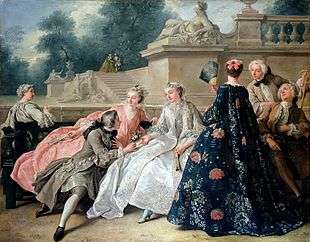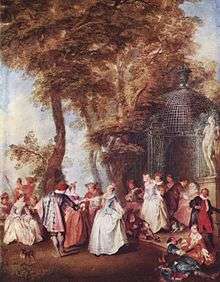Fête galante

Fête galante (French pronunciation: [fɛːt ɡalɑ̃t]) (courtship party) is a term referring to a category of painting specially created by the French Academy in 1717 to describe Antoine Watteau's (1684–1721) variations on the theme of the fête champêtre which featured figures in ball dress or masquerade costumes disporting themselves amorously in parkland settings. When Watteau applied to join the French academy in 1717, there was no suitable category for his works, so the academy simply created one rather than reject his application.[1][2][3]
Creation by Watteau
Watteau specifically created the fête galante painting style as a compromise between two drives. On the one hand, most of his funding came from private individuals, rather than from the government. On the other hand, Watteau wanted recognition from the government-appointed Académie des Beaux-Arts. The Académie ranked scenes of everyday life and portraits, the paintings most desired by private patrons, as lower than morally educational paintings illustrating history and mythology. By portraying his patrons in scenes reminiscent of the mythologized land of Arcadia, where humans had supposedly lived in leisurely harmony with nature, Watteau was able to get his paintings the highest ranking at the Académie and still flatter his buyers.
Wider context
After the death of Louis XIV in 1715, the aristocrats of the French court abandoned the grandeur of Versailles for the more intimate townhouses of Paris where, elegantly attired, they could play and flirt and put on scenes from the Italian commedia dell'arte.
Fête galante paintings are an important part of the rococo period of art, which saw the focus of European arts move away from the hierarchical, standardized grandeur of the church and royal court and toward an appreciation for intimacy and personal pleasures. Nonetheless, the lush, outdoor settings of fête galante paintings were often mined from earlier paintings, especially from Venetian paintings of the 16th century and Dutch paintings of the 17th century.
Examples
- L'Accord Parfait - painted by Watteau between 1717 and 1718. A lovely young woman holds music for a homely old man playing a flute.
- Le Collation - by Pater. Gentry flirt and pick flowers before a female nude reclining on a mound shaped like a sea shell. The nude probably represents the goddess Venus.
- Danse dans le Parc - by Lancret. Lavishly dressed courtiers dance before the statue of an heroic male nude. Male nudes were a favorite subject of history paintings, so this statue clearly is meant to elevate the dancers to "historical" status.
- Declaration of Love - painted by de Troy in 1731. De Troy's style is much more realistic than most. This painting was purchased by Frederick II of Prussia and hung in the Sans Souci palace.
- Les Deux Cousines - painted by Watteau between 1717 and 1718. Two women in white satin gowns are offered a red cape by a gallant young man. As in other fête galante paintings, Greco-Roman statues along the lake help elevate this genre scene to history painting status.
- Gardens of the Villa d'Este at Tivoli - painted by Fragonard. Classical architecture provides the backdrop for an outdoor meal and games.
- A Lady in a Garden Taking Coffee With Some Children - painted by Lancret about 1742. A woman seated next to a fountain in a lavish garden spoons some exotic coffee over to her children while two men- probably a husband and a servant- look on.
- Mezzetin - painted by Watteau between 1718 and 1720. Not technically a fête galante, this painting shows a pathetic figure from the Italian commedia dell'arte serenading a statue.
- A Pilgrimage to Cythera - painted by Watteau in 1717. Beautifully dressed aristocrats, attended by cherubs, visit an island supposedly dedicated to the ancient love goddess Cythera. This painting is often held up as the prototype of the fête galante.
- The Shepherds - painted by Watteau about 1716. This painting plays on a long tradition of aristocrats pretending to be rural shepherds, a tradition which flourished in the 18th century, most famously at the mock hamlet of Marie Antoinette.
- Venetian Pleasures - painted by Watteau between 1718 and 1719. Two dancers (the man in Arabian costume) perform for a crowd of onlookers in front of a statue of Venus. The bagpiper may be a self-portrait.
Gallery
 Jean François de Troy, "The Declaration of Love"
Jean François de Troy, "The Declaration of Love" Antoine Watteau, "Fêtes vénitiennes"
Antoine Watteau, "Fêtes vénitiennes" Antoine Watteau, "Mezzetin"
Antoine Watteau, "Mezzetin" Nicolas Lancret
Nicolas Lancret Gaston La Touche, The Arbor. The Walters Art Museum.
Gaston La Touche, The Arbor. The Walters Art Museum.
References
- ↑ Kleiner, Fred, S. (Ed.) (2011) Gardner's Art Through the Ages: A global history. Enhanced 13th edn. Boston: Wadsworth, p. 755. ISBN 978-0-495-79986-3
- ↑ Clarke, M. & D. (2010) "fête galante" in The Concise Oxford Dictionary of Art Terms. oxfordreference.com, Oxford University Press. Retrieved 8 November 2013.
- ↑ Fête Galante Glossary, National Gallery, 2013. Retrieved 8 November 2013.
External links
| Wikimedia Commons has media related to Fête galante. |